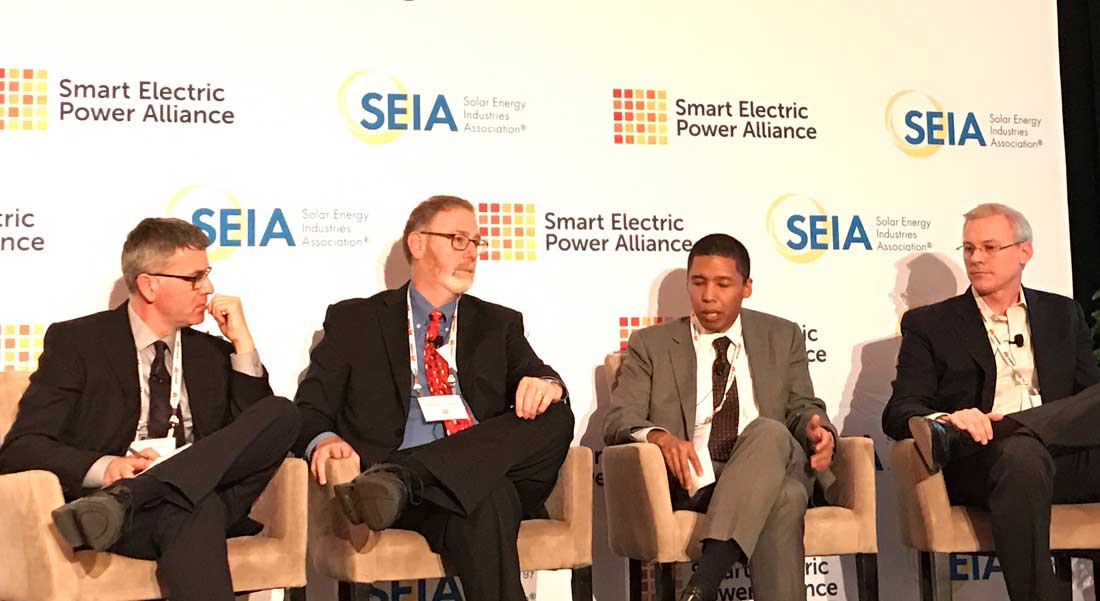By Yu-Ning Aileen Chuang
A few hours after Donald Trump delivered his victory speech, hundreds of solar industry practitioners, environmentalists and policy experts gathered in Chicago to consider what lies ahead under the president-elect.
“Clearly, there is an elephant in the room,” said Tom Kimbis, the interim president at the Washington-based Solar Energy Industries Association, recently at the opening remarks of the two-day Solar Power PV Conference & Expo.
He was talking about the election of Trump, who disbelieves in climate change and wants to revitalize fossil fuels instead of promoting renewable energy.
“We’ve been handed one clear and resounding message – and that message is change. Change is hard. As a member of the solar industry, we thrive on certainty,” Kimbis said, explaining how the industry has all the right to worry about its future.
But the future of solar isn’t that bad, added Kimbis and other speakers at the conference who delivered optimistic views of the industry’s future. They were still very concerned, however.
“I’m here to tell you that there’s one critically-important certainty that should be a comfort to all of you in this room and to the 200,000 other Americans who work in solar,” he said. “Solar is here to stay.”
He added that solar is more than the fastest-growing energy worldwide. It is an unstoppable force because the technologies around it are clean, reliable and becoming affordable.
The price of solar panels per watt has dropped to $0.4 this year, as the technology of solar and battery storage continues to improve, said Howard Learner, the president and executive director of the Chicago-based Environmental Law and Policy Center (ELPC).
“That pace of technological innovation is happening independent of what’s decided in the federal election,” said Learner. “It’s [solar is] something that makes common sense to a lot of people,” he said.
However, the possibility of Trump dumping the Obama administration’s efforts in addressing climate change – including its signature Clean Power Plan (CPP), which is poised to slash existing power plants’ CO2 emissions – is a real issue.
Myron Ebell is reportedly one of Trump’s candidates to take over the Environmental Protection Agency (EPA).
Ebell is a “climate skeptic” as Scientific American put it. He is the director of the Washington-based think tank Competitive Enterprise Institute, and has described himself as the “#1 enemy of climate change alarmism,” according to his twitter profile.
He has been openly questioned the scientific consensus that human activity is fueling global warming to an extent that the activists in Paris last year described him as one of seven “climate criminals” wanted for “destroying our future.”
Not to mention, the CPP is somehow already wounded by the Supreme Court’s “stay” decision which puts the law on hold pending judicial approval.
Kimbis admitted that the Republican control of the White House, the House and the Senate increases hurdles for the solar industry, and that the industry is about to lose its strongest ally in Congress, the retiring Senate Minority Leader Harry Reid (D-NV).
“But there are more champions out there,” Kimbis said, adding that Democratic Senators Maria Cantwell of Washington and Michael Bennet of Colorado, as well as independent Sen. Bernie Sanders of Vermont, Republican Senators Richard Burr of North Carolina and Dean Heller of Nevada are all supporters of solar energy.
Despite the federal encouragement’s possible withdrawal, the solar market’s performance may still be driven by state and city-level endeavors, said the industry experts.
Acknowledging the importance of president-led efforts on climate and energy issues, Chris Wheat, the chief sustainability officer at Chicago Mayor’s Office, said that there’s still a lot of things for some states and cities like Chicago to do to deal with climate change.
He added that the growing demand for multifamily units and low-income individuals taking on solar and energy efficiency measures is an evidence that the city should work on making solar more accessible for people.
So what will happen to the solar market after Trump takes office?
Experts said not much will take place in the near future, considering solely what Trump said about revitalizing fossil fuels like coal.
“Coal competes with natural gas and nuclear,” said Learner, adding that if Trump were to subsidize coal production that would be more at the expense of nuclear and natural gas instead of solar, which now is still a much smaller source of energy to the public.
“Also, the electricity demand is flat or declining in almost all the Midwest states,” he said, adding that it makes no sense to having more coal plants to produce more electricity.
At least one energy business expert saw a diminished future for coal.
“We will have low natural gas prices, low wind prices, low solar prices. It’s only a matter of time for those 40-year-old coal plants just have to go,” said Craig Gordon, vice president of Regulatory Affairs at Invenergy LLC, the nation’s largest independent renewable energy developer.
If the future of solar is largely determined by local efforts, the state legislatures are in the spotlight.
Take Illinois for example.
It has waited for the Clean Jobs Bill to pass for quite some time – a state bill that set to fix the Renewable Portfolio Standard so that it can take on ambitious measures in renewable energy and create more jobs.
The bill faces many challenges in winning passage in the state’s busy veto session, Learner said, pointing out that it is a short session with only five days in November and one in December.
But he was hopeful. “We are all patient and VERY persistent.”
“Let’s get it done in early 2017,” he said as the audience burst into applause.


